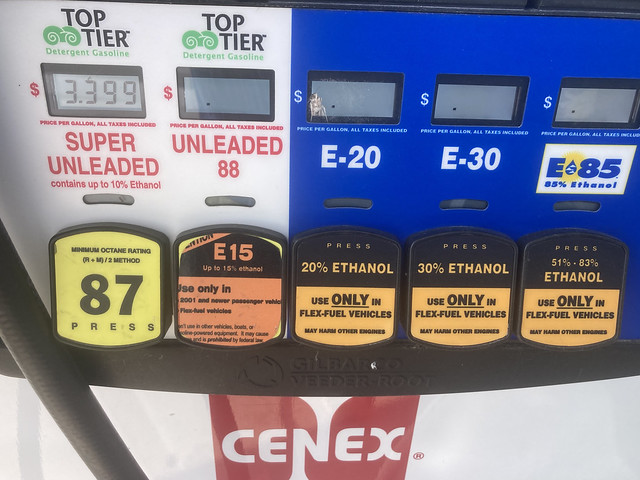Ethanol in our Gas
Contact
University of Arkansas System Division of Agriculture
Cooperative Extension Service
2301 S. University Ave.
Little Rock, AR 72204

Ethanol in our Gas
I consider myself an environmentalist, but one with hypocritical ways. I know that traveling to see the wonders of the world is an environmental insult, but I can’t resist it. Fueling up recently at a farm store in Iowa I came across a gas pump offering lots of ethanol choices. That got me to thinking about my personal history with fuel and curious about the environmental implications of adding ethanol to petroleum products.
I began my driving career more than 60 years ago when gas cost 30 cents a gallon. Those were the glory days of the automobile industry when tailfins modeled after rockets being launched into space embodied the confident and hopeful nature of the time. Discussions of miles per gallon just weren’t a concern in those times of cheap, plentiful fuel.
This era ended abruptly in 1973 with the first Middle East oil embargo. I remember sitting in a refueling line listening to commentators talking about how Brazil was unaffected by world oil shortages because they converted much of their massive sugar cane crop into ethanol. Ethanol did enter our fuel supply, but only tangentially as a result of improving our domestic fuel security.
Back in the good old days of muscle cars, a universal fuel additive was tetraethyllead. Millions of tons of lead were being spewed out of tailpipes across the nation when the EPA finally banned its use in 1996. However, the fuel industry had begun eliminating leaded fuels more than a decade earlier by switching to methyl tertiary butyl ether, or MTBE, for the anti-knock properties it provided. But MTBE began showing up as a groundwater contaminant so its days, too, were numbered, finally being banned in 20-some states by 2005. Ethanol became the new choice for an inexpensive anti-knock additive that kept the octane level at 87, the gold standard for American cars.
The world stage was besieged with conflict during the closing decade of the 20th century and the first decade of this one, much of it centered in the oil-rich Arab world. American fuel supplies were heavily dependent on tankers of crude from an unstable part of the world, so adding significant amounts of a renewable biofuel grown by midwestern farmers was an easy sell to congress.
EPA rules allowed up to 10% ethanol in fuel as early as 1978, but it was not until about 2002 that the use of ethanol as a fuel additive saw a significant increase. By 2001 most light vehicles manufactured in the US could burn ethanol containing fuels with Flex-Fuel, known as E85, approved a few years earlier. In 2000, 1.65 billion gallons of ethanol was added to fuel; a decade later it was up to 12.9 billion gallons. The legislation mandating ethanol use and providing subsidies to biofuel manufactures sweetened the pot for this segment of the industry and provided the necessary long-term stability required to get the expensive infrastructure in place. The petroleum industry has opposed the mandates, but they will probably always add ethanol to their fuel for its anti-knock properties.
Then about 2010 economists and environmental scientists started picking apart the long-term implications of using biofuels. Initially the belief was that turning 40% of your corn crop into fuel was a good thing because it made us less dependent on foreign oil and corn consumed carbon dioxide to grow and then released it when it was burned, creating no net change in greenhouse gases. Petroleum used a sequestered carbon source and added it to the atmosphere when it was burned, making the greenhouse gas buildup worse. Initially models reported converting corn to biofuel actually increased buildup by over 20%; some extreme models that assumed tropical forests would be pushed down to grow biofuels presented bleaker pictures with over 80% increase in carbon dioxide accumulation when compared to fossil fuels.
Presented with lots of conflicting studies, the government position is that ethanol does reduce carbon dioxide accumulation about 20% when compared to fossil fuels. Ethanol will remain a part of our fuel blend for the immediate future, but nothing lasts forever. Electric cars now account for about 5% of the US car market, so growing corn to convert to auto fuel may just be an interesting footnote to history in the near future.
